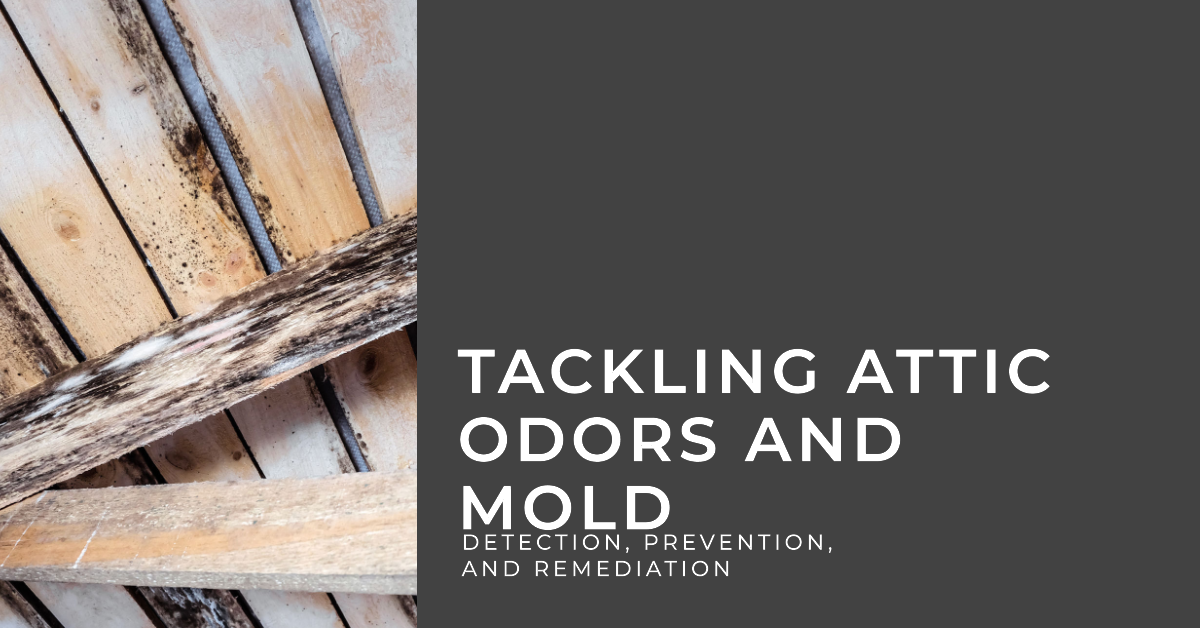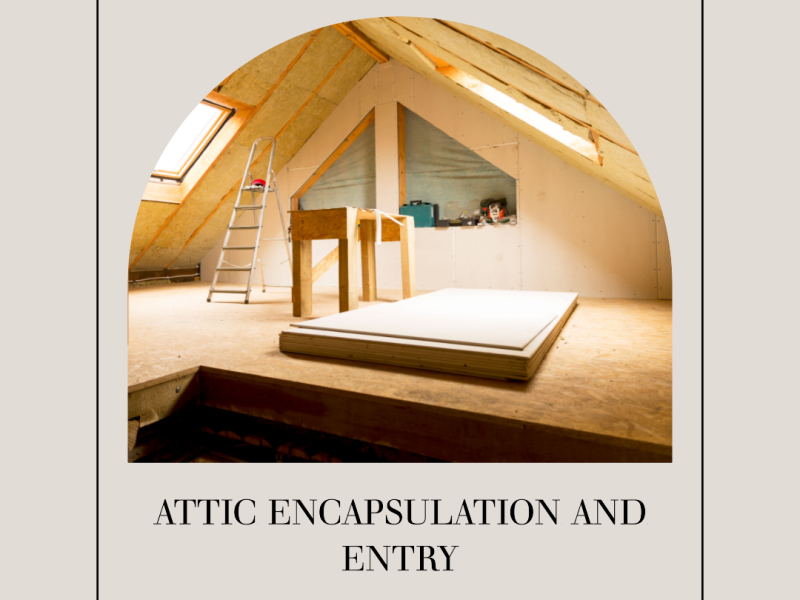I am a well-rounded expert with proficiency in several fields. My experience spans from being a dedicated chef and homemaker. As a passionate homesteader, I’ve honed my skills in sustainable living and animal care, ensuring a holistic approach to everything I undertake. Email me or Txt: (# removed due to spam, please email)
A well-maintained attic is essential for a comfortable and healthy home, but attic odors and mold can quickly create an unpleasant and unhealthy living environment.
In this comprehensive guide, we’ll explore the common sources of attic odors, how to identify attic mold, and the best practices for prevention and remediation.

Common Attic Odors
Attic smells like urine
Potential causes
Urine odors in the attic can result from a variety of sources, such as:
- Rodent infestations: Mice, rats, and squirrels often nest in attics, leaving behind urine and feces.
- Bats or birds nesting: Bats and birds may also choose your attic as a nesting place, leaving behind waste that emits a strong odor.
- Leaks or water damage: Leaking roofs or pipes can create damp conditions that cause urine-like smells.
Solutions for addressing urine odors
To eliminate urine odors in your attic, consider these steps:
- Pest control: Hire a professional exterminator to remove any rodents or other pests.
- Sanitizing the area: Thoroughly clean and sanitize affected surfaces to remove lingering odors.
- Repairing any leaks: Fix any leaks or water damage to prevent future odors.
Attic smells like sewer
Potential causes
Sewer smells in your attic can be caused by:
- Sewer gas leaks: Damaged or improperly installed sewer pipes can release sewer gas into your attic.
- Plumbing vent issues: Blocked or poorly designed plumbing vents can trap sewer gas in your attic.
- Dead animals: Decomposing rodents or birds can emit a sewer-like odor.
Solutions for addressing sewer odors
To resolve sewer odors in your attic:
- Inspecting and repairing plumbing vents: Check your plumbing vents for blockages or damage and make any necessary repairs.
- Sealing any openings or gaps: Seal any gaps or openings in your attic that may allow sewer gas to enter.
- Properly disposing of dead animals: Safely remove and dispose of any dead animals, then sanitize the area.
Understanding Attic Encapsulation and Entry

Attic Mold Identification
Identifying type of mold is vital to properly addressing the problem and ensuring that it is safely and effectively removed. Here is what to look for.
What does attic mold look like
Common types of attic mold
Attic mold can appear in various colors and textures
While black, white, and green molds are common in many areas of the home, here are some additional types of mold that are commonly found in attics:
- Chaetomium: This type of mold can be identified by its white or grayish color and cotton-like texture. It often grows on drywall, ceiling tiles, and wooden surfaces and can cause respiratory issues and allergic reactions.
- Trichoderma: This mold appears as a white or greenish-blue color and typically grows in areas with high humidity or water damage. It can cause respiratory problems and skin irritation.
- Alternaria: This mold can appear as brown or green spots and typically grows in damp areas. It can cause respiratory problems, allergic reactions, and asthma attacks.
- Ulocladium: This mold appears as black or brown spots and typically grows on damp surfaces. It can cause respiratory issues and allergic reactions.
If you suspect that there is mold in your attic, it is important to have it properly identified and removed by a professional mold remediation company.
Attempting to remove mold on your own can be dangerous and may actually spread the mold to other areas of your home.
A professional can safely and effectively remove the mold and take steps to prevent future growth.
Mold growth patterns and locations
Mold can grow in a variety of patterns and locations within an attic, depending on the specific conditions present. Here are some common patterns and locations of mold growth in attics:
- Clusters: Mold often grows in clusters, which can be irregular in shape and size. These clusters may appear as spots or blotches on surfaces like wood, insulation, or drywall.
- Along the roofline: Mold may grow along the roofline or other areas where warm air from the living space meets cold surfaces in the attic. This can occur due to inadequate ventilation or insulation.
- Near leaks: Mold may grow near leaks in the roof or around windows or vents. These areas may be damp or wet, creating a favorable environment for mold growth.
- On insulation: Mold may grow on or inside insulation that has become damp or wet due to leaks or high humidity levels.
- In corners and crevices: Mold may grow in corners or crevices where air circulation is poor and moisture can accumulate.
It is important to regularly inspect your attic for signs of mold growth and address any issues promptly to prevent further damage to your home and potential health risks.
If you suspect mold growth in your attic, it is recommended to contact a professional mold remediation company to properly identify and safely remove the mold.
What causes attic mold
Attic mold can be caused by a variety of factors, including:
- Excess moisture: Mold requires moisture to grow, so any source of excess moisture in the attic can contribute to mold growth.
- Roof leaks: Damaged shingles or flashing can allow water to enter your attic, creating an environment conducive to mold growth.
- Poor ventilation: Inadequate attic ventilation can lead to moisture buildup and condensation, which can promote mold growth.
- Condensation: High humidity levels can cause condensation on cold surfaces, such as the roof decking, creating a favorable environment for mold growth.
- Inadequate insulation: Insufficient insulation can cause temperature fluctuations and condensation, leading to mold growth. Inadequate insulation can also contribute to poor energy efficiency in the home.
- Organic materials: Mold can feed on organic materials found in your attic, such as wood, insulation, or stored items. If these materials become damp or wet, mold growth can occur.
- Poor maintenance: Neglecting regular maintenance tasks such as checking for leaks, maintaining proper ventilation, and removing clutter can contribute to mold growth in the attic.
To prevent attic mold, it is important to address any sources of excess moisture, maintain proper ventilation, ensure adequate insulation, and regularly inspect and maintain the attic space.
If you suspect mold growth in your attic, it is recommended to contact a professional mold remediation company to properly identify and safely remove the mold.

Attic Mold Remediation
Assessing the extent of the mold problem
Before attempting mold removal, it’s essential to assess the severity of the issue. Small mold problems can often be addressed with DIY methods, while larger or more complex issues may require professional remediation.
DIY mold removal vs. professional remediation
For small mold problems, you can use over-the-counter mold cleaners or a solution of bleach and water. However, if you’re dealing with extensive mold growth, toxic mold, or underlying structural issues, it’s best to consult a professional mold remediation company.
Mold removal process
The mold removal process typically involves:
- Containment of the affected area: Seal off the moldy area to prevent mold spores from spreading to other parts of your home.
- Removal of contaminated materials: Dispose of moldy materials, such as insulation or wood, according to local regulations.
- Cleaning and sanitizing surfaces: Thoroughly clean and sanitize all surfaces in the affected area to remove mold spores and prevent regrowth.
- Post-remediation testing: Conduct mold testing after the cleanup to ensure the problem has been adequately addressed.

Attic Mold Prevention
Proper attic ventilation
Proper attic ventilation is crucial for maintaining good indoor air quality, preventing mold growth, and ensuring the longevity of your home’s roof and structure. Here are some tips for achieving proper attic ventilation:
- Types of attic ventilation systems: There are several types of attic ventilation systems available, including soffit vents, ridge vents, gable vents, and turbine vents. Each type has its own advantages and disadvantages, and the best option for your home will depend on factors such as roof design, climate, and ventilation needs. Consulting with a professional can help determine the best ventilation system for your home.
- Balancing intake and exhaust vents: Attic ventilation requires a balanced mix of intake and exhaust vents to maintain proper airflow. The general rule of thumb is to have at least one square foot of ventilation for every 150 square feet of attic floor space. This ventilation should be evenly distributed between intake and exhaust vents to ensure proper air circulation.
- Sealing air leaks: Air leaks can compromise the effectiveness of your attic ventilation system, so it is important to seal any gaps or cracks that may be present in the attic. This can be done using caulk, foam, or weather stripping.
- Maintaining insulation: Proper insulation is important for maintaining a consistent temperature in the attic and preventing condensation. Insulation should be installed in a way that does not block the airflow from the intake vents to the exhaust vents.
- Regular inspections: It is important to regularly inspect your attic for signs of moisture buildup, mold growth, or other ventilation issues. If you notice any problems, contact a professional to address them promptly.
Insulation best practices
Proper insulation is crucial for maintaining a consistent temperature in your attic, preventing mold growth, and improving energy efficiency. Here are some best practices for insulating your attic:
- Insulation materials: Choose insulation materials that provide adequate thermal resistance and moisture control, such as fiberglass or cellulose. These materials are resistant to mold growth and can help prevent moisture buildup in your attic.
- Proper installation techniques: Insulation should be installed correctly to prevent gaps, moisture buildup, and condensation. Insulation should be evenly distributed and fill any gaps or spaces in the attic. Insulation should also be installed in a way that does not block airflow from intake vents to exhaust vents.
- Recommended R-value: The R-value is a measure of insulation’s ability to resist heat flow. The recommended R-value for attic insulation varies depending on your location and climate. Consult with a professional to determine the recommended R-value for your area.
By following these best practices, you can ensure that your attic is properly insulated and protected against mold growth and other issues. A well-insulated attic can also help improve energy efficiency and reduce your energy bills.
Regular attic inspections and maintenance
Conduct regular attic inspections to identify potential mold issues early on. Look for signs of water damage, leaks, or condensation, and address any problems promptly.

Attic Odor Elimination
Attic odor eliminator options
To help eliminate lingering odors in your attic, consider the following:
- Air purifiers: Use an air purifier with a HEPA filter to remove odor-causing particles from the air.
- Deodorizing sprays: Apply a deodorizing spray to affected surfaces to neutralize odors.
- Odor-absorbing materials: Place odor-absorbing materials, such as charcoal bags or baking soda, in your attic to help absorb unwanted smells.
Regular cleaning and maintenance
Maintain a clean and well-ventilated attic to help prevent odors from developing. Keep it free of pests and rodents as best as possible by patching up holes and cracks.
Improving air circulation
Ensure that your attic has proper air circulation to prevent odors and mold growth. Consider installing additional vents or an attic fan if necessary.
Planning on enhancing your attic? Check out our guide on Exploring Attic Structures and Features: A Guide to Enhancing Your Home
Conclusion
Addressing attic odors and mold promptly is essential for maintaining a healthy and comfortable living environment. By understanding the common causes of attic odors and mold, as well as the best practices for detection, prevention, and remediation, you can help protect your home and family from these unpleasant issues.



